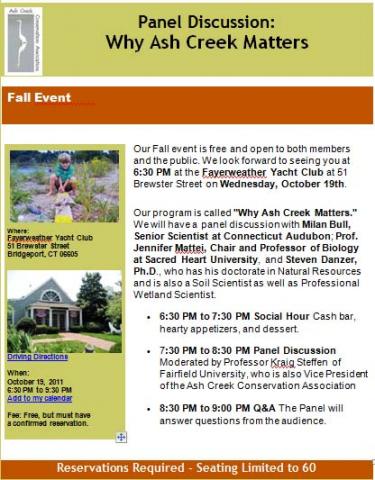On a rainy, windy evening on October 19th 60 people attended ACCA’s fall event, an expert panel discussion on “Why Ash Creek Matters.” Milan Bull, Senior Director of Science and Conservation for Connecticut Audubon mentioned that 250 different species of migratory birds have been documented in Fairfield. Most estuaries have been developed, so Ash Creek becomes an important stopover area for migratory shorebirds and is also important for nesting birds such as the osprey, which have now been enjoying their nest platform in Ash Creek for the past 20 years. Milan explained that there aren’t many undeveloped mudflats. Mudflats with docks are avoided by separmated sandpipers and other shorebirds as they could harbor predators.
Dr. Jennifer Mattei, Professor of Biology at Sacred Heart University, is also one of the Directors of Project Limulus, a collaborative research project with U.S. Fish & Wildlife. She talked about the nutrient cycle of estuaries. The Ash Creek tidal estuary catches the runoff from the Rooster River watershed that extends to Trumbull. As runoff from hard surface areas such as parking lots comes into Ash Creek, the salt marsh cleanses the water before it enters the Sound. The plants along the shoreline pick up chemical and organic elements and hold them. This serves an important function for fishermen and oystermen. You can’t put a price tag on the cleansing value of the tidal estuary. Jennifer said that the estuary gives back more thant it costs to plant the vegetation and is worthy of restoration, although the lower part of Ash Creek is very healthy and may not be in need of any restoration. The plants also hold sediment to prevent erosion. In bad storms, like the one we had in August, the plans keep homes from flooding. A healthy salt marsh keeps a good balance between predators and mosquito larvae, which means fewer mosquitos due to fish eating the larvae. Jennifer said we should look at the marsh in relation to human health. The marsh also provides us with education oppotunities aesthetic values, recreation such as kayaking, and there is even an economic value in terms of ecotourism.
Dr. Steven Danzer, a soil scientist and professional wetlands scientist, who is very familiar with Ash Creek, having worked with us over the years, talked about the relatively undeveloped shoreline of Ash Creek as being unusual in an urban area. Ash Creek has a very densely populated area surrounding a relatively pristine natural area. In most watersheds there is more development the closer you get to the Sound, whereas in Ash Creek it’s the opposite. Steve said that Ash Creek is unique and worthy of protection. The most cost effective way is to preserve what you have rather than trying to restore a natural area that has been lost to development.
Professor Kraig Steffen who was moderating the panel asked panel members for their top two priorities for ACCA. Milan said he would like to see the barrier beach (St. Mary’s Sandspit) stabilized and restored. He would also like to see invasive species, like spartina, controlled. Steve agreed with Milan and said we don’t know enough about the current condition of Ash Creek and need a starting point assessment. Jennifer agreed that we need to map what we have and noted that spartina can spread rapidly.
Questions were opened up to the audience and a graphic of possible plantings for the barrier beach (St. Mary’s Sandspit) were distributed. One longtime Black Rock resident said that the planting plan resembled the plantings that were there in the 1940’s and 1950’s on the barrier beach. The experts chimed in that the barrier beach without vegetation would not be functional because a few storms could wipe the entire beach out and expose the tidal estuary to direct wave action and flooding.


